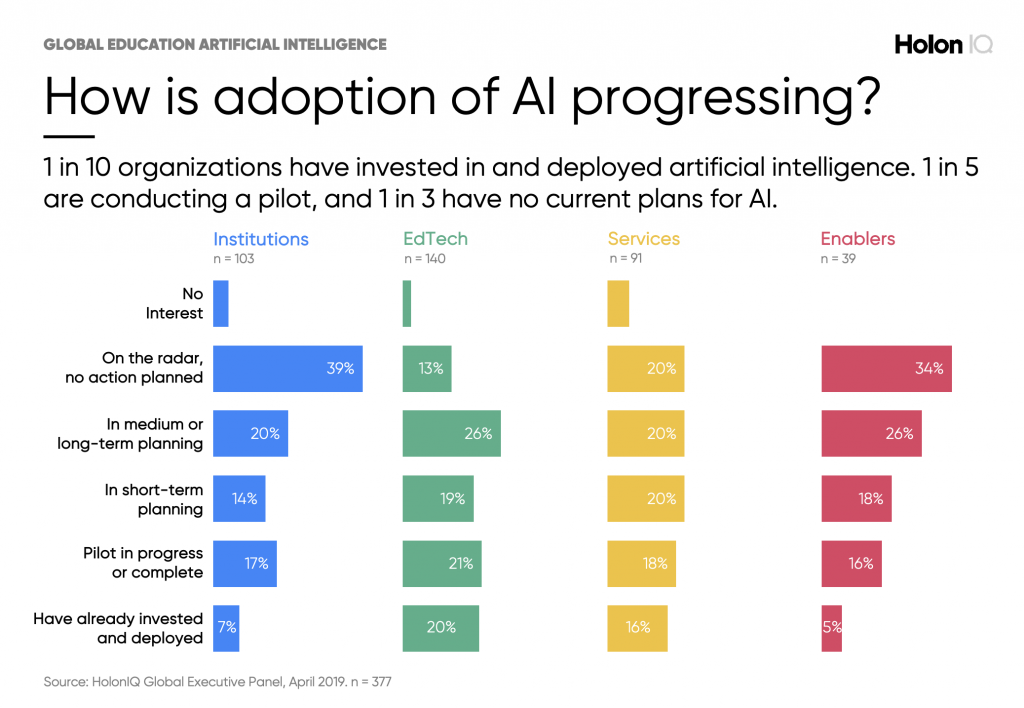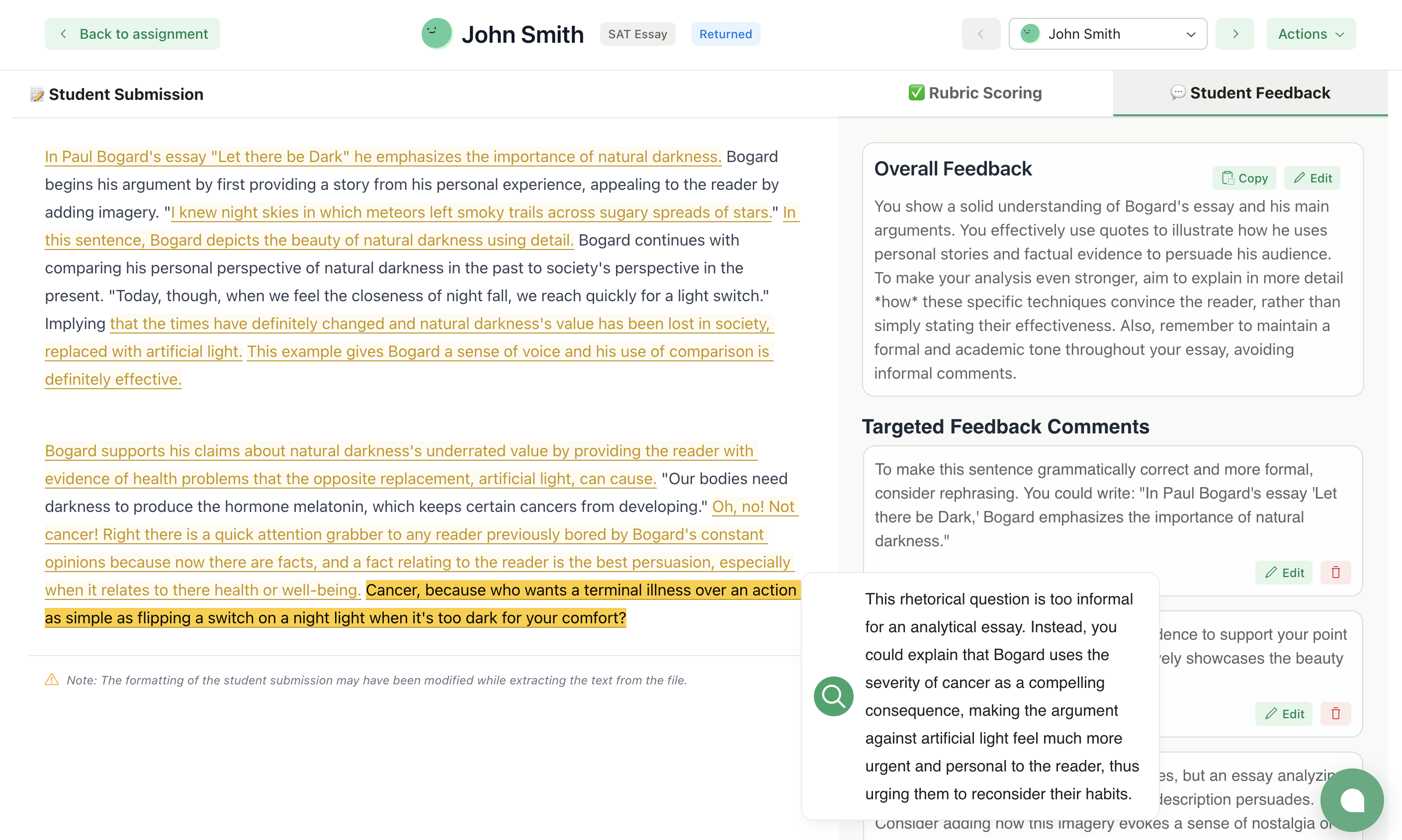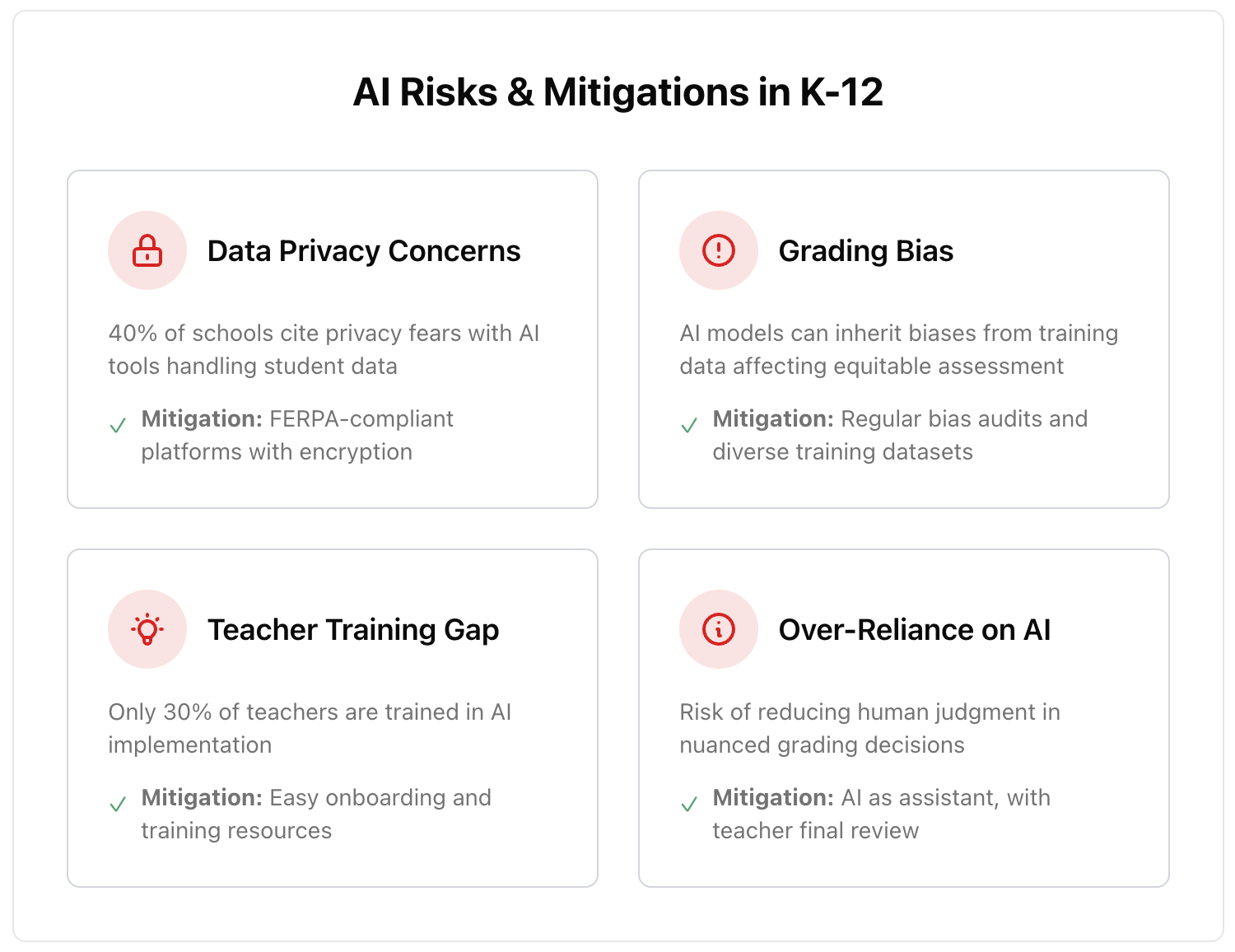The Future of AI in K-12 Education: Trends for 2026 and Beyond
As K-12 classrooms evolve, AI is no longer a novelty - it's a necessity. By 2026, AI adoption in U.S. schools is projected to reach 70%, according to a 2025 Coursebox report, driven by demands for personalized learning and teacher efficiency. Trends like adaptive grading and real-time analytics are reshaping how educators assess math worksheets, essays, and quizzes, freeing time for mentorship.
Table of Contents
- 1. The Current State of AI in K-12 Education
- 2. Key Trend 1: Adaptive Grading for Personalized Instruction
- 3. Key Trend 2: Real-Time Analytics and Data-Driven Insights
- 4. Key Trend 3: AI for Social-Emotional Learning and Equity
- 5. Key Trend 4: Addressing Risks – Privacy, Bias, and Implementation
- 6. How GradingPal Prepares K-12 Classrooms for AI's Future
- 7. Preparing Your Classroom for AI in 2026
The Current State of AI in K-12 Education
AI in K-12 education has surged, with 60% of U.S. schools incorporating tools for grading and planning, per a 2025 K-12 Dive report. From automated essay scoring to analytics for formative assessments, AI addresses teacher workload - teachers spend 10-15 hours weekly on grading, contributing to 44% burnout rates (MentalUP, 2025). Current tools focus on efficiency, but 2026 will emphasize personalization, with AI adapting to individual needs like ELL students or those with IEPs.
Exploding Topics forecasts AI creating new learning opportunities, such as microlearning modules and neuroeducation integration. However, a 2025 EdWeek survey shows mixed teacher feelings: 65% excited about AI for personalized learning, but 40% concerned about data privacy and bias. As the U.S. responds to global mandates - like China's K-12 AI education push (Online Education, 2025) - tools must prioritize equity and compliance.
GradingPal is ahead, with OCR for handwritten math worksheets and real-time analytics for adaptive grading. Our free Pro plan (valued at $19/mo or $149/yr) lets teachers test these trends risk-free for 6 months. Explore GradingPal's AI features.

Key Trend 1: Adaptive Grading for Personalized Instruction
Adaptive grading, a cornerstone of 2026 AI trends, tailors assessments to student needs, adjusting difficulty based on performance. Edsembli predicts this will transform K-12 curricula, with AI providing individualized feedback on math worksheets or essays. For a 4th-grade fraction worksheet, adaptive AI might simplify problems for struggling students while challenging advanced ones with multi-step equations.
In practice, adaptive grading uses machine learning to analyze responses in real-time. A 2025 FETC report highlights AI's role in social-emotional learning, where adaptive tools detect frustration via response patterns and suggest breaks or hints. This personalizes learning, boosting outcomes by 30% in diverse classrooms (Coursebox, 2025).
GradingPal embodies this trend with rubric-based adaptive feedback: for a 7th-grade algebra essay, it scores and suggests, "Mastered basics - try real-world applications." Our analytics dashboard tracks progress, aligning with Common Core for equitable instruction. With the free Pro plan (valued at $19/mo), test adaptive grading for 6 months. See adaptive grading in action.
Key Trend 2: Real-Time Analytics and Data-Driven Insights
Real-time analytics will dominate K-12 AI in 2026, providing instant data on student performance to inform teaching. Online Learning Consortium forecasts AI dashboards will enable "smarter learning" by analyzing trends during lessons. For example, during a 10th-grade geometry unit, analytics might reveal 65% class-wide errors in proofs, prompting immediate reteaching.
This trend builds on microlearning and online platforms, with AI aggregating data from quizzes and worksheets for personalized paths. A 2025 COSN report notes AI in cybersecurity and 3D printing design accelerates insights, extending to grading. Risks include data breaches (K-12 Dive, 2025), but FERPA-compliant tools mitigate this.
GradingPal's dashboard delivers real-time analytics, visualizing mastery on math worksheets (e.g., "80% proficient in fractions") and suggesting interventions. Our free Pro plan (valued at $19/mo) includes unlimited access for 6 months, preparing teachers for 2026 data-driven classrooms. Dive into GradingPal analytics.

Key Trend 3: AI for Social-Emotional Learning and Equity
AI's integration with social-emotional learning (SEL) will grow in 2026, helping students build self-awareness and resilience alongside academics. FETC 2025 highlights AI tools for SEL, analyzing response sentiment in essays to detect stress. For a 6th-grade reflective essay, AI might flag neutral tone as low engagement, suggesting "Share more feelings to deepen reflection."
Equity is key, with AI addressing diverse needs - e.g., adaptive prompts for ELL students on reading worksheets. Exploding Topics notes neuroeducation's rise, where AI tailors content to cognitive styles. However, bias risks persist; 2025 EdWeek warns of over-reliance on AI without teacher oversight.
GradingPal supports SEL and equity with sentiment-aware feedback and customizable rubrics for IEPs. Our free Pro plan (valued at $19/mo) enables this for 6 months, ensuring inclusive K-12 learning. Explore equity features.

Key Trend 4: Addressing Risks – Privacy, Bias, and Implementation
While AI promises innovation, 2026 trends emphasize risk mitigation. K-12 Dive reports rising concerns over data breaches and harassment from AI tools, with 40% of schools citing privacy fears. FERPA compliance will be non-negotiable, alongside bias audits to ensure equitable grading.
Implementation challenges include training - Online Education notes the U.S. lags behind China's AI mandate, with only 30% of teachers trained. Edsembli stresses automation's role in smarter learning, but without safeguards, AI could exacerbate inequities.
GradingPal addresses this with FERPA-compliant, bias-reduced AI and easy onboarding. Our free Pro plan (valued at $19/mo) includes training resources for 6 months, helping teachers implement safely. Review our privacy measures.

How GradingPal Prepares K-12 Classrooms for AI's Future
GradingPal is built for 2026's AI landscape, combining adaptive grading, real-time analytics, and SEL integration. Our OCR grades handwritten math worksheets, while NLP personalizes essay feedback, aligning with Common Core for equity. We support microlearning trends by automating quizzes and tracking neuroeducation insights.
The free Pro plan (valued at $19/mo or $149/yr) gives you unlimited access for 6 months, including FERPA-compliant tools to mitigate risks. Teachers using GradingPal report 60-80% time savings enabling focus on mentorship. See how GradingPal prepares classrooms for AI.

Preparing Your Classroom for AI in 2026
To prepare for AI in 2026, start small: pilot adaptive tools for math worksheets, train on analytics, and audit for bias. Integrate SEL prompts in feedback and ensure FERPA compliance. GradingPal simplifies this with our free Pro plan for 6 months - unlimited uploads, no commitment.
AI will make K-12 education more inclusive and efficient, but success lies in thoughtful implementation. Ready to lead? Start your free Pro plan today - value $19/mo, yours for 6 months.

Ready to Prepare Your Classroom for AI's Future?
Get our free Pro plan (valued at $149/yr) for 6 months - adaptive grading, real-time analytics, and SEL integration, no credit card required.
No credit card required • Free for US teachers • Set up in minutes